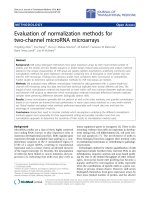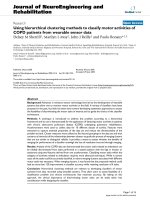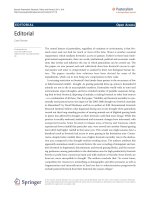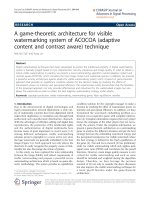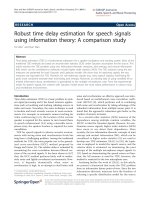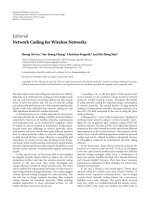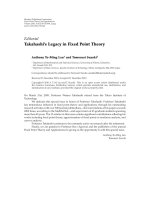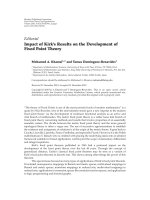Báo cáo hóa học: " Editorial Information Theoretic Methods for Bioinformatics" potx
Bạn đang xem bản rút gọn của tài liệu. Xem và tải ngay bản đầy đủ của tài liệu tại đây (429.78 KB, 2 trang )
Hindawi Publishing Corporation
EURASIP Journal on Bioinformatics and Systems Biology
Volume 2007, Article ID 79128, 2 pages
doi:10.1155/2007/79128
Editorial
Information Theoretic Methods for Bioinformatics
Jorma Rissanen,
1, 2
Peter Gr
¨
unwald,
3
Jukka Heikkonen,
4
Petri Myllym
¨
aki,
2, 5
Teemu Roos,
2, 5
and Juho Rousu
5
1
Computer Learning Research Center, University of London, Royal Holloway TW20 0EX, UK
2
Helsinki Institute for Information Technology, University of Helsinki, P.O. Box 68, 00014 Helsinki, Finland
3
Centrum voor Wiskunde en Informatica (CWI), P.O. Box 94079, 1090 GB Amsterdam, The Netherlands
4
Laboratory of Computational Engineering, Helsinki University of Technology, P.O. Box 9203, 02015 HUT, Finland
5
Department of Computer Science, University of Helsinki, P.O. Box 68, 00014 Helsinki, Finland
Received 24 December 2007; Accepted 24 December 2007
Copyright © 2007 Jorma Rissanen et al. This is an open access article distributed under the Creative Commons Attribution
License, which permits unrestricted use, distribution, and reproduction in any medium, provided the original work is properly
cited.
The ever-ongoing growth in the amount of biological data,
the development of genome-wide measurement technolo-
gies, and the gradual, inevitable shift in molecular biology
from the study of indiv idual genes to the systems view; all
these factors contribute to the need to study biological sys-
tems by statistical and computational means. In this task, we
are facing a dual challenge: on the one hand, biological sys-
tems and hence their models are inherently complex, and on
the other hand, the measurement data, while being genome-
wide, are typically scarce in terms of sample sizes (the “large
p,smalln” problem) and noisy.
This means that the traditional statistical approach,
where the model is viewed as a distorted image of something
called a true distribution which the statisticians are trying to
estimate, is poorly justified. This lack of rationality is particu-
larly st riking when one tries to learn the structure of the data
by testing for the truth of a hypothesis in a collection where
none of them is true. Similarly, the Bayesian approaches that
require prior knowledge, which is either nonexistent or vague
and difficult to express in terms of a distribution for the pa-
rameters, are subject to modeling assumptions which may
bias the results in an unintended manner.
It was the editors’ intent and hope to encourage applica-
tions of techniques for model fitting influenced by informa-
tion theory, originally created for communication theory but
more recently expanded to cover algorithmic information
theory and applicable to statistical modeling. In this view,
the objective in modeling is to learn structures and proper-
ties in data by simply fitting models without requiring any of
them to be “true”. The performance is not measured by any
distance to the nonexisting “truth” but in terms of the prob-
ability they assign to the data, which is equivalent to the code
length with which the data can be encoded, taking advantage
of the regular features the model prescribes to the data. This
task requires information and coding theoretic means. Simi-
larly, the frequently used distance measures like the Kullback-
Leibler divergence and the mutual information express mean
codelength differences.
D. Benedetto et al. study correlations and compressibil-
ity of proteome sequences. They identify dependencies at the
range of 10 to 100 amino acids. The source of such depen-
dencies is not entirely clear. One contributing factor in the
case of interprotein dependencies is likely to be sequence du-
plication. The dependencies can be exploited in compression
of proteome sequences. Furthermore, they seem to have a
role in evolutionary and structural analysis of proteomes.
C. M. Hemmerich and S. Kim also use information the-
ory for studying the correlations in protein sequences. They
base their method on computing the mutual information of
nonadjacent residues lying at a fixed distance d apart, where
the distance is varied from zero to a fixed upper bound. The
mutual information vector formed by these statistics is used
to train a nearest-neighbor classifier to predict membership
in protein families with results indicating that the correla-
tions between nonadjacent residues are predictive of protein
family.
H. M. Aktulga et al. detect statistically dependent ge-
nomic sequences. Their paper addresses two applications.
First, they identify different parts of a gene (maize zmSRp32)
that are mutually dependent without appealing to the usual
assumption that dependencies are revealed by a considerable
amount of exact matches. It is discovered that dependencies
exist between the 5
untranslated region and its alternatively
spliced exons. As a second application, they discover short
2 EURASIP Journal on Bioinformatics and Systems Biology
tandem repeats which are useful in, for instance, genetic pro-
filing. In both cases, the used techniques are based on mutual
information.
The objective in the paper by A. Rao et al. is to dis-
cover long-range regulatory elements (LREs) that determine
tissue-specific gene expression. Their methodology is based
on the concept of directed information,avariantofmutual
information introduced originally in the 1970s. It is shown
that directed information can be successfully used for select-
ing motifs that discriminate between tissue-specific and non-
specific LREs. In particular, the performance of directed in-
formation is better than that of mutual information.
F. Fabris et al. present an in-depth study to BLOSUM—
block substitution matrix scores. They propose a decompo-
sition of the BLOSUM score into three components: the mu-
tual information of two compared sequences, the divergence
of observed amino acid co-occurence frequencies from the
probabilities in the substitution matr ix, and the background
frequency divergence measuring the stochastic distance of
the observed amino acid frequences from the marginals in
the substitution matrix. The authors show how the result
of the decomposition, called BLOSpectrum, can be used to
analyze questions about the correctness of the chosen BLO-
SUM matrix, the degree of typicality of compared sequences
or their alignment, and the presence of weak or concealed
correlations in alignments with low BLOSUM scores.
The paper by J. Conery presents a new framework for
biological sequence alignment that is based on describing
pairs of sequences by simple regular expressions. These reg-
ular expressions are given in terms of right-linear grammars,
and the best grammar is found by use of the MDL prin-
ciple. Essentially, when two sequences contain similar sub-
strings, this similarity can be exploited to describe the se-
quences with fewer bits. The precise codelengths are deter-
mined with a substitution matrix that provides conditional
probabilities for the event that a particular symbol is re-
placed by another particular symbol. One advantage of such
a grammar-based approach is that gaps are not needed to
align sequences of varying length. The author experimentally
compares the alignments found by his method with those
found by CLUSTALW. In a second exper iment, he measures
the accuracy of his method on pairwise alignments taken
from the BAlisBASE benchmark.
S. C. Evans et al. explore miRNA sequences based on
MDLcompress, an MDL-based grammar inference algo-
rithm that is an extension of the optimal symbol compres-
sion ratio (OSCR) algorithm published earlier. Using MDL-
compress, they analyze the relationship between miRNAs,
single nucleotide polymorphisms (SNPs) and breast can-
cer. Their results suggest that MDLcompress outperforms
other grammar-based coding methods, such as DNA se-
quitur, while retaining a two-part code that highlights bio-
logically significant phrases. The ability to quantify cost in
bits for phrases in the MDL model allows prediction of re-
gions where SNPs may have the most impact on biological
activity.
The partially redundant third position of codons
(protein-coding nucleotide triplets) tends to have a strongly
biased distribution. The amount of bias is known to be
correlated with G+C (guanine-cytosine) composition in the
genome. In their paper, H. Suzuki et al. quantify the corre-
lation of G+C composition with synonymous codon usage
bias, where the bias is measured by the entropy of the third
codon position. They show that the correlation depends on
various genomic features and varies among different species.
This raises several interesting questions about the different
evolutionary forces causing the codon usage bias.
The paper by P. E. Meyer et al. tackles the challenging
problem of inferring large gene regulatory networks using in-
formation theory. Their MRNET method extends the maxi-
mum relevance/minimum redundancy (MRMR) feature se-
lection technique to networks by formulating the network in-
ference problem as a series of input/output supervised gene
selection procedures. Empirical results are competitive with
the state-of-the-art methods.
P. Kontkanen et al. study the problem of computing the
normalized maximum likelihood (NML) universal model for
Bayesian networks, w hich are important tools for modeling
discrete data in biological applications. The most advanced
MDL method for model selection between such networks is
based on comparing the NML distributions for each network
under consideration, but the naive computation of these dis-
tributions requires exponential time with respect to the given
data sample size. Utilizing certain computational tricks, and
building on earlier work with multinomial and Naive Bayes
models, the authors show how the computation can be per-
formed efficiently for tree-structured Bayesian networks.
ACKNOWLEDGMENTS
We thank the Editor-in-Chief for the opportunity to prepare
this special issue, and the staff of Hindawi for their assistance.
The greatest credit is of course to the authors, who submit-
ted contributions of the highest quality. We also thank the
reviewers who have had a crucial role in the selection and
editing of the ten papers appearing in the special issue.
Jorma Rissanen
Peter Gr
¨
unwald
Jukka Heikkonen
Petri Myllym
¨
aki
Teemu Roos
Juho Rousu
